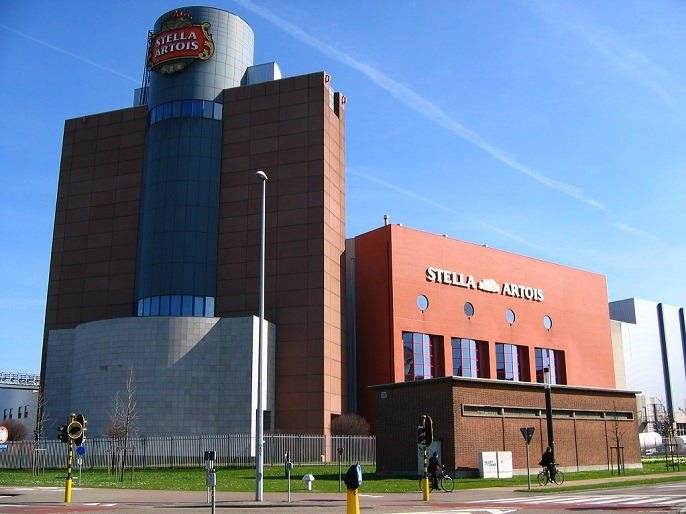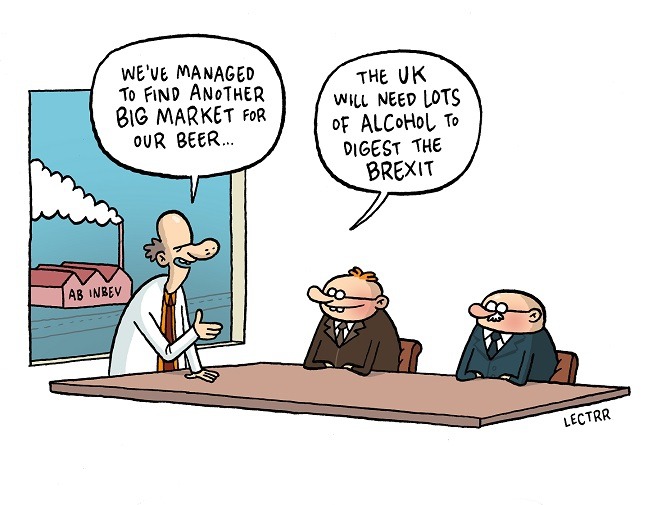The headquarters of Anheuser-Busch InBev in Leuven are modest and unassuming for the world’s biggest drinks company. It is where flagship drink, Stella Artois, is still brewed, and some two million litres of beer are produced in its industrial plant every day. But a mere 600 people work there out of the company’s army of 200,000.
AB InBev is a curious beast. Its stable of beers include familiar Belgian names like Stella, Jupiler, Leffe and Hoegaarden, as well as US brands like Budweiser, Miller and Beck’s, Australia’s Fosters, Canada’s Labatt, Brazil’s Brahma, Britain’s Bass, Germany’s Löwenbräu and Mexico’s Corona. It has over 200 brands, produces over 500 million barrels of beer a year, and makes around €40 billion in annual sales. The company is intensely secretive about its corporate arrangements: while AB InBev’s global headquarters are in Leuven, the functional management office is in New York, while most of the key executives are Brazilian, including CEO Carlos Brito.
AB InBev offers tours of the brewery, but they only show two areas: a room with 20 giant kettles, and a view of the bottling and canning operations. Every hour, the Leuven plant produces 40-60,000 bottles, around 80,000 cans, and around 800 kegs.
Their diligent tour guide dutifully explains the production process – from the four essentials of hops, barley, yeast and water to the final product in the glass – as well as a history of beer going back to ancient Mesopotamia. The history lesson says the beer’s roots go back to Leuven’s Den Hoorn brewery in 1366 – a date that still sits on the Stella Artois logo – and the decision centuries later by head brewer Sébastien Artois to buy the brewery in 1717 and rename it Brouwerij Artois. Stella was launched in 1926 as a Christmas beer, but later became available all year-round.
The corporate history shows how the Artois brewery took off in the 1950s when it started doing its own bottling. It then began investing in marketing, but it was only in 1987 that Stella bought out another brewery, the Piedboeuf Brewery in Jupille that makes Jupiler: they jointly formed Interbrew. By 2004, Interbrew merged with Brazil’s AmBev to form InBev. And the 2008 takeover of Anheuser-Busch, producer of Budweiser beer, created AB InBev. In 2015, it completed a €100 billion purchase of another rival, SABMiller.
In 2003, Interbrew accounted for just 6% of the market. Ten years later, as AB InBev, it was 20.6%. The new colossus now accounts for one in every three beers sold globally.
Now the world’s biggest drinks company, its corporate image is bland and hollow. Press inquiries are met with meaningless statements claiming that, “We are deeply committed to providing consumers the highest-quality products and never compromise on ingredients, or the care and craftsmanship that go into brewing our portfolio”, and, “Our Dream is to bring people together for a better world and we are committed to driving growth that leads to better living for more people in more places.”

This corporate behemoth contrasts with the classic image of local, small-scale Belgian brewing, perhaps by Trappist monks, a tradition that helped earn Belgian beer culture a position in UNESCO’s cultural heritage list last year. Indeed, locals have turned away from Belgium’s onetime standard-bearer of beer. Stella may be seen internationally as a quintessentially Belgian beer, but at home its appeal has collapsed: it has just a 6.5% market share, far behind stablemate Jupiler’s 35%, according to market research firm Euromonitor International.
But a far bigger challenge is lying in wait for AB InBev. While the company has gobbled up rivals, its global market is in danger of peaking. Industry trends show consumer demand suffering a noticeable slide: while the global alcohol market contracted 1.3% in 2016, beer sales (which account for three-quarters of all alcohol drunk by volume) fell 1.8%, the International Wine and Spirits Record (IWSR) found.
The overall decline last year is almost entirely because of economic downturns in three of the five biggest markets: beer sales in China fell 4.2%, 5.3% in Brazil and 7.8% in Russia. Longer-term trends show problems in mature markets: in the US, production volumes have stagnated over the past decade. In other key markets such as Germany, France and the UK, they fell by roughly 10% over the same period.
That is worrying news for AB InBev: China overtook the US to become the world’s biggest market for beer by volume in 2001, and now guzzles a quarter of all beer. But consumption per person peaked in 2013 and dropped further last year.
This reflects how beer-drinking changes, as people get richer. A 2016 study by Liesbeth Colen and Johan Swinnen of the University of Leuven looked at how income growth affected beer consumption in 80 countries between 1961 and 2009. It found that as GDP per person increased in poorer countries, beer became more popular, but fell when it reached around €23,000 per person. This, they say, was likely down to health concerns: while historically seen as a hearty and nutritious food, beer drinking now raises issues from alcoholism and drunk driving to the calories in the glass and the risks of obesity.
Hence the move for SABMiller: with this economy of scale, AB InBev can move into new markets, particularly Africa and Latin America, to offset its decline in more mature places. Africa has the world’s largest working age population and the bulk of the drinkers coming of legal drinking age within the next 10 years are expected in Africa. As Carlos Brito has said, Africa will be a “critical driver of future growth for the combined company.”
None of this is surprising for a company seeking ever greater market share. It is reflected in AB InBev’s approach to one of the more innovative beer trends of recent years: craft breweries. Young urban consumers are testing new, original varieties, often from microbreweries. In the US, craft brewers are now officially beating the big beer makers: where overall beer production rose just 0.5% in 2014, output from small brewers surged by 18%, giving them an 11% volume share. This is also happening in Europe where there are now many times more brands on shelves than a decade ago.
AB-InBev also claims to embrace innovation, but its ideas – including Cubanisto, a rum-flavored beer – have fallen flat. Its actual response to the competition is brutally simple. Instead of creating its own quirky beers, it is just buying up existing craft brewers like Birra del Borgo in Italy, London-based Camden Town, Kaiba in China, and Belgium’s Ginette and Bosteels.
So little wonder that last November, AB InBev was rumoured to be preparing a bid for Coca-Cola: the soft drinks giant had annual revenue last year of €35 billion, and a takeover would likely put the combined annual revenue over the $100 billion mark (€85 billion). Even if the beer falls flat, there will always be other drinks to snatch.
By Leo Cendrowicz

